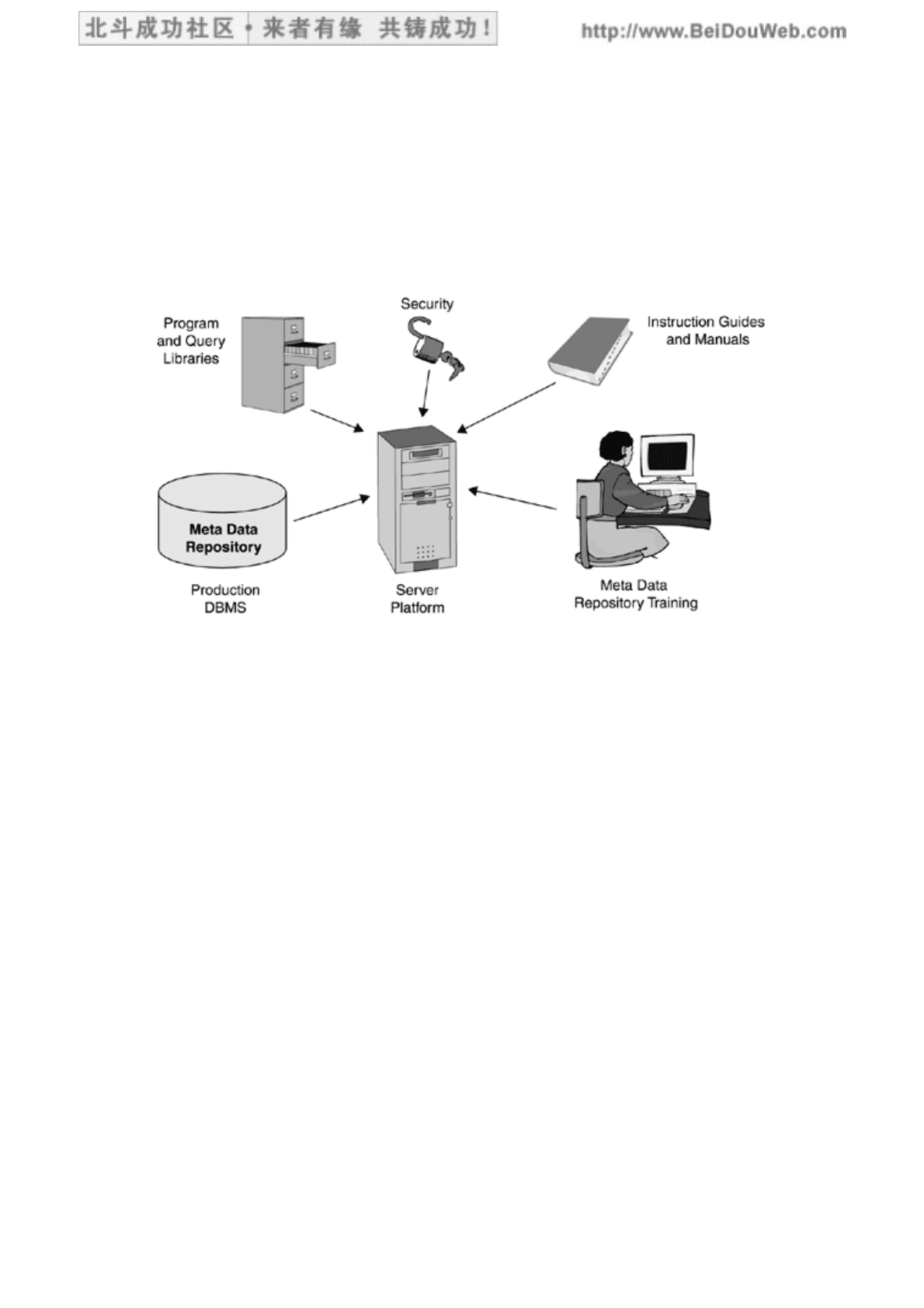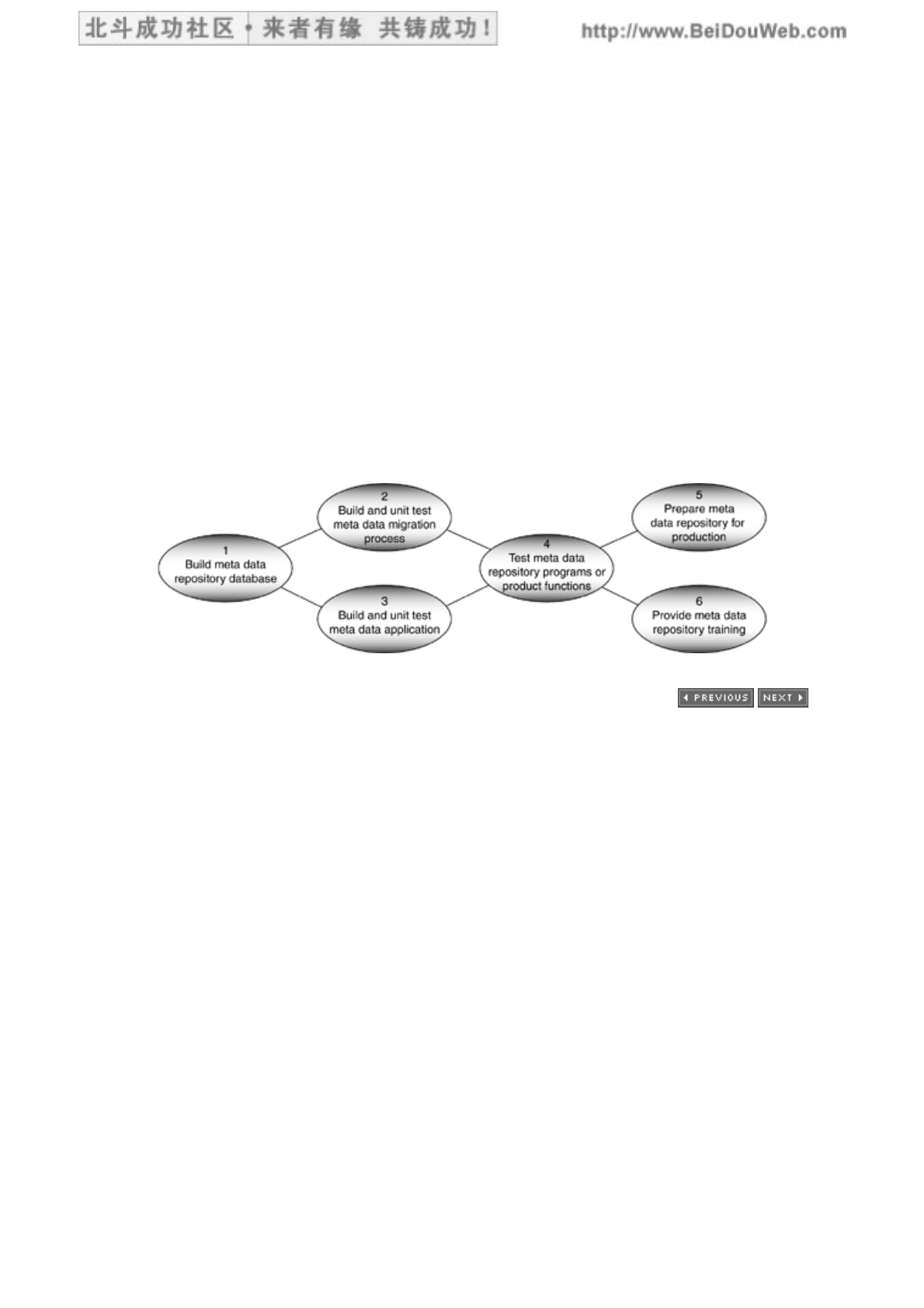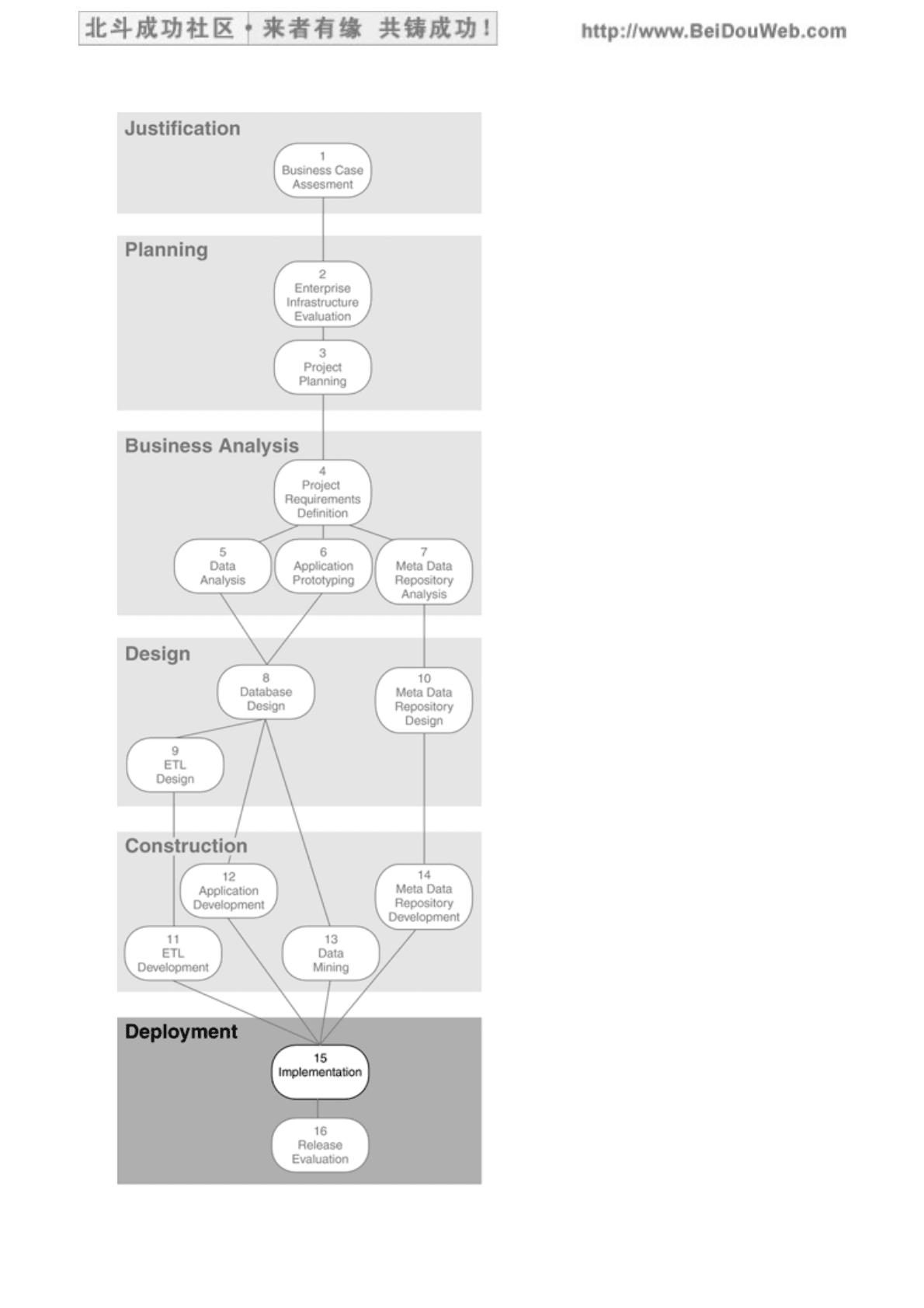Moss L.T., Atre S. Business intelligence roadmap: The complete project lifecycle for decision-support applications
Подождите немного. Документ загружается.


trained differently on how to use the meta data repository either through the
access interface or directly and interactively. Business analysts need to know
how to access the meta data repository to help them select BI data for ad hoc
queries. Technicians need to know how to use meta data to help them maintain
the BI applications and how to retrieve meta data in order to deliver it as an
integral part of the BI application reports and queries.
Figure 14.3. Preparation for Meta Data Repository Rollout
A best practice is to provide "just enough" training "just in time." The first training
session, no longer than one day, should provide a review of the meta data
repository, how it is organized, and how to extract some meta data components, as
well as an introduction to one or two basic functions. Tell the trainees that the first
training session is only an introduction to the meta data repository and that they will
need additional training. After one or two weeks of hands-on practice while
performing their job duties, the trainees should return for another one- or two-day
training session to learn about more advanced features of the meta data repository.
Use the training session as an opportunity to introduce the business people to the
help desk staff who will support them. Mention to the business people that the help
desk staff will be mentoring them as they become proficient in navigating through
the meta data repository and through the entire BI decision-support environment.
Encourage the business people to establish their own network. In this network, they
could help each other not only with using the meta data repository but also with
learning about the business data and the application features of the BI decision-
support environment as a whole.
Meta Data Repository Directory
Some thought should be given to the best way to organize and present the meta
data repository contents to the business people and technicians. The meta data
repository contents could be organized into a directory that serves as a map for
easier navigation through the meta data repository. For example, the contents of a
general meta data repository directory could be organized into three major
groupings: business directory, information navigator, and technical directory, as
shown in Table 14.2. These three groupings could list the meta data components
北斗成功社区 BeiDouWeb.com 教育音视频/电子书/实用资料文档/励志音乐影视 仅供免费试用/版权原著所有
411/631

contained within each grouping, or they could show a layer of lower-level
subgroupings.
A meta data repository directory could be designed as fancy as a Web site map or as
simple as a basic context-sensitive matrix. The directory could also be expanded and
included as part of the online help facility of the BI decision-support environment as
a whole to serve as a potential entry point into the meta data repository. If a meta
data repository directory is developed, its use should be covered during the training
sessions.
Table 14.2. Example of a Meta Data Repository Directory
Business
Directory
Information
Navigator
Technical
Directory
Audience
Business staff
Business staff
Technical staff
Meta Data Components
and Functions
Business terms
Aggregations
Security
Source of data
Transformations
BI target
databases
Currency of
data
Query library
Indices
Ownership
Drill-down functions
Data mapping
Data quality
Roll-up functions
Quality metrics
[ Team LiB ]
北斗成功社区 BeiDouWeb.com 教育音视频/电子书/实用资料文档/励志音乐影视 仅供免费试用/版权原著所有
412/631

[ Team LiB ]
Meta Data Repository Development Activities
The activities for meta data repository development do not need to be performed
linearly. Figure 14.4 indicates which activities can be performed concurrently. The
list below briefly describes the activities associated with Step 14, Meta Data
Repository Development.
Build the meta data repository database.
If you are building a meta data repository, regardless of whether it is based on
an entity-relationship design or an object-oriented design, generate the data
definition language (DDL) and run it to create the meta data repository
database structures. Also, generate the data control language (DCL) and run it
to establish create, read, update, and delete (CRUD) authority on the meta data
repository database. If you are licensing a meta data repository product, install
and test all product components, especially the meta data repository database.
Set up CRUD authority on the meta data repository product to allow execution
of the meta data migration process and the reports and to allow direct access to
the meta data repository.
1.
Build and unit test the meta data migration process.
Once you have created the meta data repository database, you must develop
the meta data migration process, including the tool interface process and the
meta data transformation programs that will prepare the extracted meta data
for the meta data repository. If you licensed a meta data repository product
and if the import facility of the product is used to populate the meta data
repository, test it to verify that it functions as expected.
2.
Build and unit test the meta data application.
If you are building the meta data repository, you must also develop the meta
data application functions, including the access interface process and the online
help function, as well as the meta data reports and queries. If the meta data
repository is a licensed product, you must test its application functions
(interfaces, reports, queries). If it is necessary to enhance the product with
additional functionality, write and test the additional code.
3.
Test the meta data repository programs or product functions.
Test all meta data repository programs or product functions from beginning to
end through formal integration or regression testing. Every component of the
meta data migration process as well as every component of the meta data
application must be tested vigorously. Perform integration testing or regression
testing with a formal test plan; run prepared test cases, log the actual test
results on a test log, and compare them to the expected results. Once the meta
data repository programs or product functions have been thoroughly integration
or regression tested, the business people and the technicians can perform their
combination QA/acceptance testing.
4.
Prepare the meta data repository for production.5.
北斗成功社区 BeiDouWeb.com 教育音视频/电子书/实用资料文档/励志音乐影视 仅供免费试用/版权原著所有
413/631

Install and test the server platform for the production meta data repository.
Create the DDL and DCL for the production meta data repository database.
Write operating procedures for the operations staff, with instructions for
running regularly scheduled meta data repository programs. Also write a
reference guide for the help desk staff and for the business people with
instructions on how to use the meta data repository. Establish other
procedures, such as monitoring of database performance and meta data usage.
5.
Provide meta data repository training.
Since a meta data application can be as complicated as any business
application, training is an important aspect. Business people and liaison
personnel, such as "power users" and help desk staff, have to be trained in the
use of the meta data repository database, the online help function, reports, and
queries. Develop and present in-house training sessions or schedule training
through the meta data repository vendor.
6.
Figure 14.4. Meta Data Repository Development Activities
[ Team LiB ]
北斗成功社区 BeiDouWeb.com 教育音视频/电子书/实用资料文档/励志音乐影视 仅供免费试用/版权原著所有
414/631

[ Team LiB ]
Deliverables Resulting from These Activities
Physical meta data repository database
This is the physical database of the meta data repository. Its tables, columns,
primary keys, foreign keys, and CRUD authorization are defined to the DBMS
with Structured Query Language (SQL) instructions containing DDL and DCL
statements.
1.
Meta data repository test plan
The test plan should state the purpose for each meta data repository test and
show a schedule for running the tests in a predetermined sequence. It should
also describe the test cases, including input criteria and expected output
results. A test log should document when the tests were run, who ran them,
and what the test results were.
2.
Meta data repository programs
All meta data migration programs, access interface programs, tool interface
programs, report programs, query scripts, and online help function programs
for the meta data repository should be coded and tested. If a meta data
repository product is being used, all of the meta data repository product
functions should be tested.
3.
Meta data repository program library
All meta data repository programs and scripts should reside in the meta data
repository program library. The entire meta data migration process, as well as
the meta data application functions, should have been integration or regression
tested and QA/acceptance tested.
4.
Meta data repository production documentation
Meta data repository production documentation includes the following:
- Operating procedures for operations staff covering all scheduled meta
data repository jobs
- Meta data repository reference guide for the help desk and the business
people with instructions on how to use the meta data repository
5.
Meta data repository training materials
The training materials for internal meta data repository training should include
presentation slides, instructor notes, student workbooks, exercises and their
solutions, and any additional pertinent handouts.
6.
[ Team LiB ]
北斗成功社区 BeiDouWeb.com 教育音视频/电子书/实用资料文档/励志音乐影视 仅供免费试用/版权原著所有
415/631

[ Team LiB ]
Roles Involved in These Activities
Business representative
The business representative should participate in acceptance testing the meta
data application functions the same way he or she participates in acceptance
testing the ETL and access and analysis functions of the BI application. The
business representative must also take part in the meta data repository
training.
Database administrator
The database administrator has to create the database structures (tables,
columns, indices, and so on) for the meta data repository. He or she grants
authority to technicians, business people, tools, and programs for accessing and
writing to the meta data repository database. He or she also assists the meta
data administrator with the meta data migration process and the database
access calls for the meta data application functions.
Meta data administrator
The meta data administrator must install the meta data repository product, if
one is being licensed. If a meta data repository is being built from scratch, the
meta data administrator must oversee the development effort. He or she must
install and test the production server for the meta data repository. He or she
also coordinates the meta data repository development activities with the
database administrator, the meta data repository developers, and the testers.
Meta data repository developers
The meta data repository developers should write the code for the meta data
migration process, including the tool interface process, and for the meta data
application, including the access interface process and online help function.
Testers
Since developers should never test their own code, independent testers (other
developers) should perform the integration and regression tests.
[ Team LiB ]
北斗成功社区 BeiDouWeb.com 教育音视频/电子书/实用资料文档/励志音乐影视 仅供免费试用/版权原著所有
416/631

[ Team LiB ]
Risks of Not Performing Step 14
Without a meta data repository you would have to develop a complicated custom
meta data application to extract meta data from all the tools and DBMSs to produce
meta data reports. That would be too difficult, too time consuming, too coding
intensive, too convoluted, and too frustrating. Other meta data approaches, such as
expanding the use of a CASE tool, may work as stopgap measures but not as long-
term solutions. CASE tools are not equipped to accept meta data from ETL tools or
OLAP tools, just as ETL tools are not equipped to accept meta data from CASE tools,
and so on. A meta data repository is the only solution.
[ Team LiB ]
北斗成功社区 BeiDouWeb.com 教育音视频/电子书/实用资料文档/励志音乐影视 仅供免费试用/版权原著所有
417/631

[ Team LiB ]
Bibliography and Additional Reading
Aiken, Peter H. Data Reverse Engineering: Slaying the Legacy Dragon. New York:
McGraw-Hill, 1996.
Beck, Kent. Extreme Programming Explained: Embrace Change. Boston, MA:
Addison-Wesley, 2000.
Dick, Kevin. XML: A Manager's Guide. Boston, MA: Addison-Wesley, 2000.
Hetzel, Bill. The Complete Guide to Software Testing, Second Edition. New York: John
Wiley & Sons, 1993.
Humphrey, Watts S. Winning with Software: An Executive Strategy. Boston, MA:
Addison-Wesley, 2002.
Marco, David. Building and Managing the Meta Data Repository: A Full Lifecycle
Guide. New York: John Wiley & Sons, 2000.
Tannenbaum, Adrienne. Metadata Solutions: Using Metamodels, Repositories, XML,
and Enterprise Portals to Generate Information on Demand. Boston, MA: Addison-
Wesley, 2002.
Enterprise Warehouse Solutions: http://www.EWSolutions.com
[ Team LiB ]
北斗成功社区 BeiDouWeb.com 教育音视频/电子书/实用资料文档/励志音乐影视 仅供免费试用/版权原著所有
418/631

[ Team LiB ]
Chapter Fifteen. Step 15:
Implementation
北斗成功社区 BeiDouWeb.com 教育音视频/电子书/实用资料文档/励志音乐影视 仅供免费试用/版权原著所有
419/631

北斗成功社区 BeiDouWeb.com 教育音视频/电子书/实用资料文档/励志音乐影视 仅供免费试用/版权原著所有
420/631
